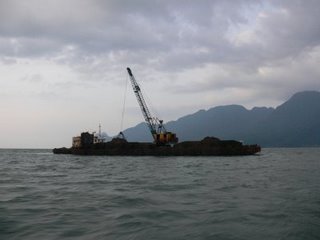 Just kidding, no jobs here I’m afraid. Apologises to any job seekers who googled there way here. Back button time for you and good luck with you endeavours. This meandering post is about the need for research on Sarawak’s Irrawaddy dolphins.
Just kidding, no jobs here I’m afraid. Apologises to any job seekers who googled there way here. Back button time for you and good luck with you endeavours. This meandering post is about the need for research on Sarawak’s Irrawaddy dolphins.A number of studies of Irrawaddy dolphins have been conducted in various countries in Southeast Asia and population estimates have been made for these sites. Here are a few stats to ponder.
Indonesia, Mahakam River, population estimated at 70 individuals based on a 2005 survey. For more info see YK-RASI
Ayeyarwady River, Myanmar, population estimated at 59 individuals based on a 2003 surevy. For more info see IUCN
Malampaya Sound, Palawan, Philippines, population estimated at 77 individuals based on a 2001. For more info see IUCN
Songkhla Lake, Thailand, population now extremely low, fewer than 50. For more info see IUCN
Mekong River, Cambodia, best estimate is 69 based on 2003 survey. For more info see IUCN
Yeah, I know, the above numbers make for pretty depressing reading. At each of the sites surveyed the population is between 50-80 individuals. It doesn’t take a rocket scientist to work out that Southeast Asia’s Irrawaddy dolphins need all the help they can get. The first step in that process is to understand what is going on. To determine conservation priorities you need to conduct scientific research, estimate the population, examine threats, etc. This is already happening elsewhere in Southeast Asia with research being conducted in Cambodia, Indonesia, Thailand, Myanmar and the Philippines. Another project to is about to begin in Indonesia at Sembilang National Park.
So, how about Sarawak? What is the dolphin population in the Kuching area? Sorry folks, at present no one has a clue. Whilst one-off dolphin surveys have been conducted in Sarawak, these just show that there are dolphins out there. Whilst this is a welcome start, follow-up work is needed. Ideally a long term study, or for starters a preliminary study to estimate the dolphin population around Kuching and perhaps some outreach work with fishing communities so that a bycatch monitoring system can be set up in key villages.
So far the local scientific community, the wildlife agency and NGOs have largely ignored Sarawak’s Irrawaddy dolphins. In many ways this is not surprising; after all there are enough issues to look at on land in Sarawak, let alone looking out to sea.
But looking out to sea can be rewarding, especially when there are dolphins on your doorstep.
The fact that relatively large numbers (25+) of Irrawaddy dolphins have been sighted in the Santubong area and groups are regularly sighted at Buntal, Muara Tebas and other rivers and estuaries close to Kuching, suggests that there could be a significant population near Kuching. I am no marine mammal expert - I just like dolphin watching - so I can not say how significant these sightings are.
But when I look at the population stats from elsewhere in the region, 59 in the Ayeyarwady, 77 in the Malampaya Sound, 70 in the Mahakam, etc., it gets me thinking. It makes me think how lucky I am to be able to see four or five groups of Irrawaddy dolphins in one day. It makes me wonder how many dolphins there are near Kuching. It makes me think that maybe, just maybe, the population around Kuching could be pretty significant. It also makes me think - where are the folks with binoculars and clipboards. It sure would be nice to see some researchers out in the bay observing the dolphins instead of just fishermen, tourists and the odd bridled tern.
In many ways the tourism industry has put Sarawak’s Irrawaddy dolphins in the public eye. More and more people are aware that dolphins are found near Kuching and this increased awareness has to be a good thing. What is required now is an increase in scientific knowledge.
In 2000 the Sarawak Forest Department conducted a marine mammal survey along the coast of Sarawak in collaboration with the Borneo Marine Research Institute at the University Malaysia Sabah. The results of the 2000 survey were published in ‘Hornbill’, a Forest Department publication. This is what the researchers recommended.
“Irrawaddy dolphins and finless porpoises in coastal waters, estuaries and rivers of Sarawak should be given serious attention. The creation of reserves for the protection and management of dolphins is strongly encouraged…The impact of incidental catches of dolphins should be investigated…Further studies on the populations, behaviour and ecology of inshore cetaceans should be conducted.”
Some sound recommendations. Unfortunately, six years on, no in-depth ‘further studies’ have been conducted. No serious attention has been given. The impact of bycatch has not been investigated and no dolphin reserves have been set up.
If the Irrawaddy dolphin population around Kuching is significant, and without the data, that is a big if, then Sarawak has an opportunity to play an important role in the conservation of Irrawaddy dolphins in Southeast Asia. But for this to happen research needs to be conducted and more attention needs to be given to the dolphins on the doorstep of Kuching.
